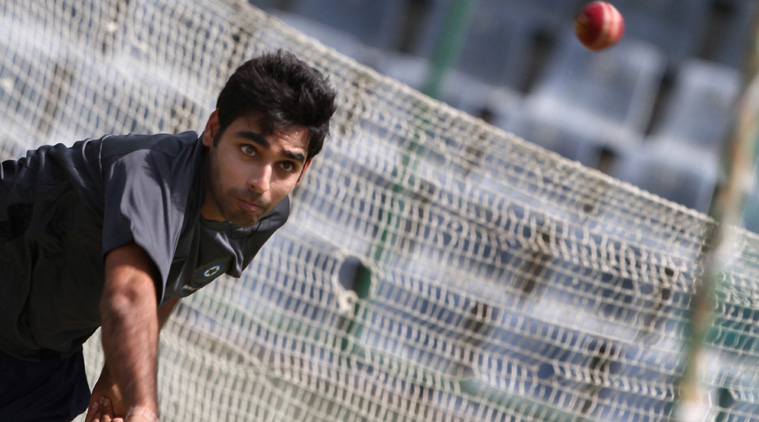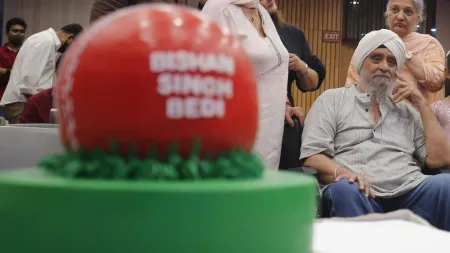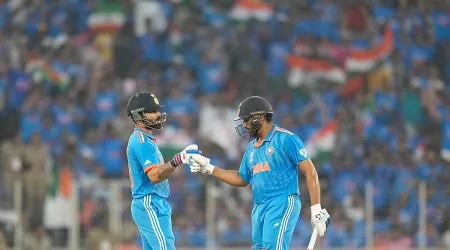- India
- International
Bhuvneshwar Kumar hopes to meet expectations on his maiden Australia tour
In conversation with Jonathan Selvaraj, India's Bhuvneshwar Kumar, explains his rare craft- swing bowling.
 Bhuvneshwar Kumar is only the second bowler and the first pacer to win the Polly Umrigar Award. (Source: IE Photo by Ravi Kanojia)
Bhuvneshwar Kumar is only the second bowler and the first pacer to win the Polly Umrigar Award. (Source: IE Photo by Ravi Kanojia)
NCR region is one big construction site. As builders keep building, concrete towers need selling. And if you have flats to sell, you can’t really do better than having an international cricketer plug your offering. As of last Sunday, the flavour of the season, at least on the basis of hoardings placed all along NH24 from New Delhi to Meerut, is Bhuvneshwar Kumar.
Dressed in a black cardigan, the pacer begins his promise of ‘affordable luxury’ under the still-growing high rises of Ghaziabad. He is there along the the urban villages on either side of the highway as well as at the chaotic construction sites on the outskirts of Meerut. These hoardings only stop when you take a right turn at the dust-choked Begumpul crossing.
Here, the dust has settled, the trees verdant, the constricted lanes have given way to straight wide roads and large green playing areas. This part of Meerut is one the British established. A couple of centuries ago, a few mutinous soldiers broke out of the old jail here to set off the 1857 revolt. A more modern hero versus English rivals, Bhuvneshwar is also usually to be found just down the road at the Victoria Park cricket ground.
The ground is as English as it gets. Built by the British in 1936, Victoria Park is a tidy space bordered by a low whitewashed wall. The outfield is soft and green with a small white building in one corner. O’Donnell’s Pavilion, it’s called.
From the time he arrived here in a shared autorikshaw as a 10-year-old with an oversized kitbag to now in his own SUV wearing an India embossed jersey, Victoria Park is where Bhuvneshwar has honed his craft. And while it’s in the colonial part of the city where he first learned to swing the ball, England proper, during the five match Test series between July and August, is where Bhuvneshwar really made it talk.

In a series that began with a growl and ended in a whimper, Bhuvi was perhaps the only one to return with his reputation enhanced.
With 247 runs during the series, he was India’s fourth highest scorer and with 19 wickets at 26.63 he was the side’s leading wicket taker. A five-for and a pair of fifties saved the Trent Bridge Test while a six wicket haul won India the Lord’s Test. On Tuesday, this week, it was the England performance that decidedly swung the Polly Umrigar Award his way. The 24-year-old incidentally is the first pacer to have won the BCCI’s award for the best player in the country.
Between the months of July and August this year, it seemed he could do little wrong. The balls pitched just outside off stump posed questions batsmen just couldn’t avoid. And although released at a tempting 130kmph, it proved all but impossible to get away as it swung seemingly in whichever direction his wrist willed it. For much of the series, Bhuvneshwar was in the zone. “Rhythm,” he says, correcting you. “A batsman is in the zone. A bowler is in rhythm.”
THAT HOLY SPACE
Phrasing apart, the two areas provide similar experiences. “If you are in rhythm you find things are happening very easily. It doesn’t matter what kind of conditions you are playing in. You don’t feel that you are doing something for the first time. For example if I go to Australia and I am in good rhythm I will never feel that this place or condition is new to me,” he says.
Bhuvneshwar says he knows whether he is in rhythm or not even before he releases the ball. “When you are in rhythm you never find the hardness or softness of the ground. When you are not in good rhythm you always realise that this surface is very hard or this surface is very soft. In good rhythm you just concentrate on bowling. I haven’t had a lot of experience in internationals but I can make out just by his running whether a fast bowler is in a good rhythm or not,” he says.
If all that seems a little too esoteric to understand, Bhuvneshwar helps illustrate his point with an example from the World T20 in Bangladesh earlier this year. Making the ball dart one way and then another, Bhuvneshwar returned a spell of 3-0-3-0 against the defending champions, West Indies. Their openers, Chris Gayle and Dwayne Smith, neither scored runs nor got out — something that usually happens when you struggle to get bat on ball.
“Usually you aim for an area on the pitch, but I was hitting the right spot consistently and moving it exactly where I wanted it to. I couldn’t hear the crowd and I didn’t even feel like I had to try.” Bhuvneshwar says.
That game, however, makes another point about being in rhythm. “For a bowler form is something that gets you wickets. Rhythm gets you bounce and swing but it won’t always give you wickets. But as a bowler I want to be in rhythm because it gives you a good feeling. And bowling is all about the feeling,” he says.
For all the mystical quality that that term evokes, Bhuvneshwar believes he has a rather simple key to regularly entering that space. “You don’t want to lose rhythm but somehow it vanishes. But it never vanishes for a long time. If I have had a long break from the game, it isn’t easy to find that rhythm. It isn’t about bowling everyday but by bowling regularly I find that I get back into rhythm quickly,” Bhuvi adds.
The need to be in rhythm is doubly crucial when bowling in Tests. “I might normally bowl ten overs in a spell but If I am not in rhythm I will get tired after bowling six,” he says. Once he gets in rhythm though, the 17 unchanged overs he bowled at Lord’s become possible. Patiently curling the ball away from off stump, Bhuvneshwar prised out England’s openers Alastair Cook and Sam Robson. Ian Bell too fell to one that jagged in towards the end of the marathon effort. “If I wasn’t in good rhythm, I wouldn’t have been able to bowl that spell. Rhythm gave me stamina and fired some muscles that I wasn’t aware of before,” he says. “The moment you start thinking about what you want to do, you are in trouble. Everything needs to be instinctive.”
In the poker game between bat and ball, Bhuvneshwar knows he isn’t the only one who can count his opponents cards. “Batsmen know that I swing the ball both ways so they will be ready for that. My goal is to delay what they think I am going to do until the last moment,” he says. That, however, is something that doesn’t usually happen. “The batsman isn’t a fool. He knows what I am thinking. He will consciously plan not to get out in that manner. If he does get out, he usually gets out some other way because that’s not where his focus is. So if the plan is to get a batsman out caught behind, I will probably only get him out that way around 20 percent of the time,” he says.
This explains why Bhuvneshwar’s favourite mode of dismissal isn’t necessarily what a fan’s may be. As such, it isn’t the booming inswinger that bowled Pakistan’s Nasir Jamshed — getting him his debut international wicket — nor is it the delivery he bowled in the 2008 Ranji final that handed Sachin Tendulkar his first duck in domestic cricket. It is instead a wicket that doesn’t seem particularly impressive or momentous — that of Ian Bell on the morning of the second day of the Manchester Test.
“Bell is a contender to get out behind the wickets. Generally I bowl with the field six and three. But I took a fielder from leg into the slips. I bowled maybe four overs at him just outside off and going away. He must have known what I was trying to do and he was probably careful about it, but bowling is all about inducing mistakes. Eventually he went after one and was caught behind. That gave me a lot of satisfaction,” he says.
With all his recent exploits, it is easy to forget that India has seen a big swinging bowler before. A couple of years ago, RP Singh and Praveen Kumar — both of whom share space on the Lord’s honour board with Bhuvneshwar — were promoting builder homes. Then, of course, there was Ashish Nehra. And Irfan Pathan. Some were told to try their hand at batting, others to bowl just a bit faster. Each of them were discarded. For what it’s worth, Bhuvneshwar says he knows his limitations.
“I have always known that my strength has been to swing the ball. Once I played at a good level, I realised that I wasn’t as quick as the other guys. If you aren’t mentally tough or if you don’t have guidance you start to think you aren’t good enough and that you need to get faster. And what happens is that you lose your strength. At whatever level I played, I took wickets because of swing, not because of pace. That doesn’t mean that I won’t try and get stronger so I can bowl faster but I won’t try to get faster by compensating with my swing,” he says.
This, says Bhuvneshwar, is just why he doesn’t mind it much when MS Dhoni keeps up to the stumps. “It opens up the option of LBW as the batsman now can’t leave his crease,” he says.
Bhuvi is similarly matter-of-fact about his batting. Even before the England series, he had a first-class century — scored in difficult circumstances in a Duleep Trophy semifinal in 2012. In England he hit three half centuries and shared a tenth wicket partnership of 138 with Mohammed Shami. “I have never been picked as an all rounder for any team and I don’t want that tag either. Whenever I get a chance I want to contribute to my team. But I am not going to suddenly become the next Kapil Dev,” he insists. “And neither do I want to be one.”
when.
NOT ON SONG
If there appears a note of caution in his voice it is because Bhuvneshwar is aware of times when he hasn’t been as successful as he was in England. Expected to thrive in swing friendly New Zealand in January this year, Bhuvneshwar only picked up four wickets in five ODIs at just under 60 runs each. He wasn’t picked for the subsequent Tests. And on a previous tour of Australia, as an exchange student at the Center for Australian Sport (CAS) in 2009, he less than impressed.
“At CAS, I thought to myself, ‘Shit, this ball isn’t swinging much’. But I had time to adjust. I wasn’t getting a lot of swing but I was getting the ball to bounce. If I was accurate with my line and length and getting just a little bit of swing and good bounce, it was as effective.”
In preparation for the upcoming tour of Australia, this time with the Test side, Bhuvneshwar says he got the curator at Victoria Park to roll a rock hard wicket to imitate the pitches Down Under. There will be other variables he will have to deal with, however.
Only 11 Tests old right now, he will likely find himself bearing the responsibility of the leader of the attack, along with Ishant Sharma. He claims he is ready for it.
“Even when I made my debut, I didn’t feel pressure. I find it easier to play according to the situation. I have an idea of what to expect so there isn’t any fear about what is going to happen,” he says. “I know that the ball isn’t going to swing or do as much as it was doing in England. It’s about adapting and I think I will be able to do that.”the swing bowler explains his rare craft.
SWINGING IT HIS WAY
Bhuvneshwar Kumar is only the second bowler and the first pacer to win the Polly Umrigar Award. The award has previously been won by Sachin Tendulkar ( in 2006-07 and 2009-10), Virender Sehwag (in year 2007-08), Gautam Gambhir (for the year 2008-2009), Rahul Dravid (in 2010-11), Virat Kohli in (2011-2012) and off spinner R Ashwin (for the year 2012-2013).
In the BCCI awards for the year 2007-2008, when Virender Sehwag won the Polly Umrigar Trophy, Bhuvneshwar won the award for U-19 player of the year. He is the only player to have won both these awards.
Bhuvneshwar finished with 263 runs and 22 wickets in seven Tests during the qualification period between October 2013 and September 2014. He also took 17 wickets from 22 ODIs, and seven wickets from as many T20 internationals during the period considered for the award.
The year in question has been a breakthrough year for Bhuvneshwar particularly in the Test format. Before this he had taken 6 wickets in four Tests at an average of 39.83 as opposed to a bowling average of 27.63 in the award period and 30.25 over his career.
However, the same hasn’t been true about his bowling in the limited overs format. He averaged 56.82 per wicket in the award period in contrast to an average of 21.96 in seventeen games until that point and a career average of 36.59. His T20 average is 19.71 in the award period as opposed to 17.54 over his career.
Get latest updates on IPL 2024 from IPL Points Table to Teams, Schedule, Most Runs and Most Wickets along with live score updates for all matches. Also get Sports news and more cricket updates.











































